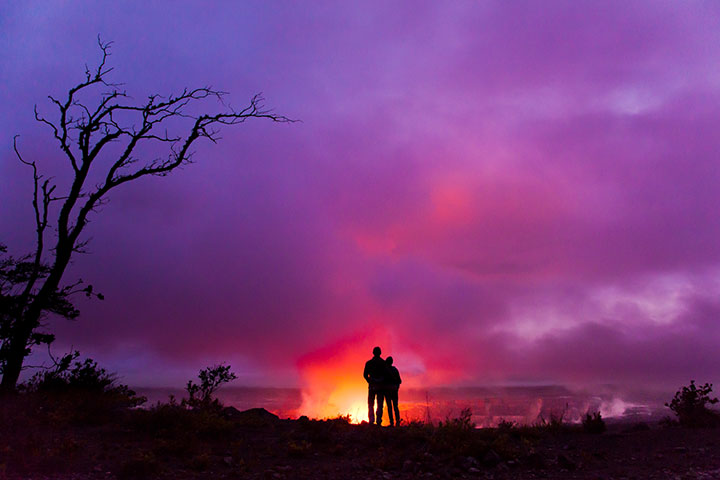
Halemaumau Crater at night. Photo courtesy of Hawaii Tourism Authority (HTA) / Tor Johnson.
You can’t come to Hawaiʻi Island without hearing the name “Pele” for she is perhaps the most visible of all the ancient Hawaiian gods and goddesses.
Pele Makes Her Home at Halemaumau Crater
Otherwise known as Pelehonuamea, “She who shapes the sacred land,” this goddess of fire and volcanoes continues to devour the Big Island with molten lava, also creating new land in the process.
Small towns and entire forests have been wiped out by Pele’s passionate, unpredictable and volatile temper, and while her presence is felt on all of the Hawaiian islands, legend maintains that she resides in one of the most active volcanoes in the world — at the summit of Kīlauea, within Halema‘uma‘u crater at Hawaii Volcanoes National Park on the Big Island.
Pele (pronounced peh-leh) sends rivers of lava down the mountainside, adding more than 70 acres of new land to the southeastern coast since 1983.
Travel to her home, stand at the edge of the edge of the crater and many say they are moved by the spirit of this goddess.
Mysterious and Respected
In folklore, Pele travels throughout the islands, appearing to mankind as a beautiful young woman, or as an old woman, sometimes accompanied by a white dog. Refuse her requests and suffer her wrath, legends say. Tales of encounters with Pele include drivers who picked up an old woman dressed all in white on roads in Kilauea National Park, only to look in the mirror to find the back seat empty. Others say Pele’s face has mysteriously appeared in their photos of the lava lake within the crater or molten lava flows. Among the people of the islands, Pele is revered and respected.
Don’t Take the Rocks or Eat the Berries
An important note to travelers looking for authentic souvenirs of their Hawaiian vacation: never remove and take home a lava rock from the islands. Lava is a sacred piece of the fire goddess, and bad luck will befall anyone who dares to remove it from Pele’s home.
It’s also considered offensive to eat any of the ‘ohelo berries that grow along the edges of Halema‘uma‘u caldera without first offering them to the goddess or requesting permission.
Tahitian Exile
Ancient legends of Pele are wrought with fierce feuds and jealous outbursts. One story tells of how Pele, one of six daughters and seven sons born to Haumea (the Earth goddess) and Kane Milohai (creator of the sky, earth and heavens), came to Hawaiʻi after being exiled from Tahiti by her father because of her temper.
She fought with her elder sister Namakaokaha‘i, the water goddess, whose husband Pele had seduced. (Most of the lovers Pele took were not lucky enough to escape with their lives.)
Pele’s oldest brother, Kamohoali‘i, the king of the sharks, gave her a canoe that she and several of her siblings paddled across the sea, all the while battling with Namakaokaha‘i.
Finding a Home in Hawaii
The fire goddess landed first on Kaua‘i, but every time she thrust her o‘o (digging stick) into the earth to dig a pit for her home, Namakaokaha‘i would flood the pits. Pele moved down the chain of islands in order of their geological formation, eventually landing on the Big Island where she resides today.
The ancient Hawaiians personified all natural forces as gods and goddesses, and thus Pele continues to make her majesty known from the mountain to the sea — the stark landscape a reminder of her power to both create and destroy.







